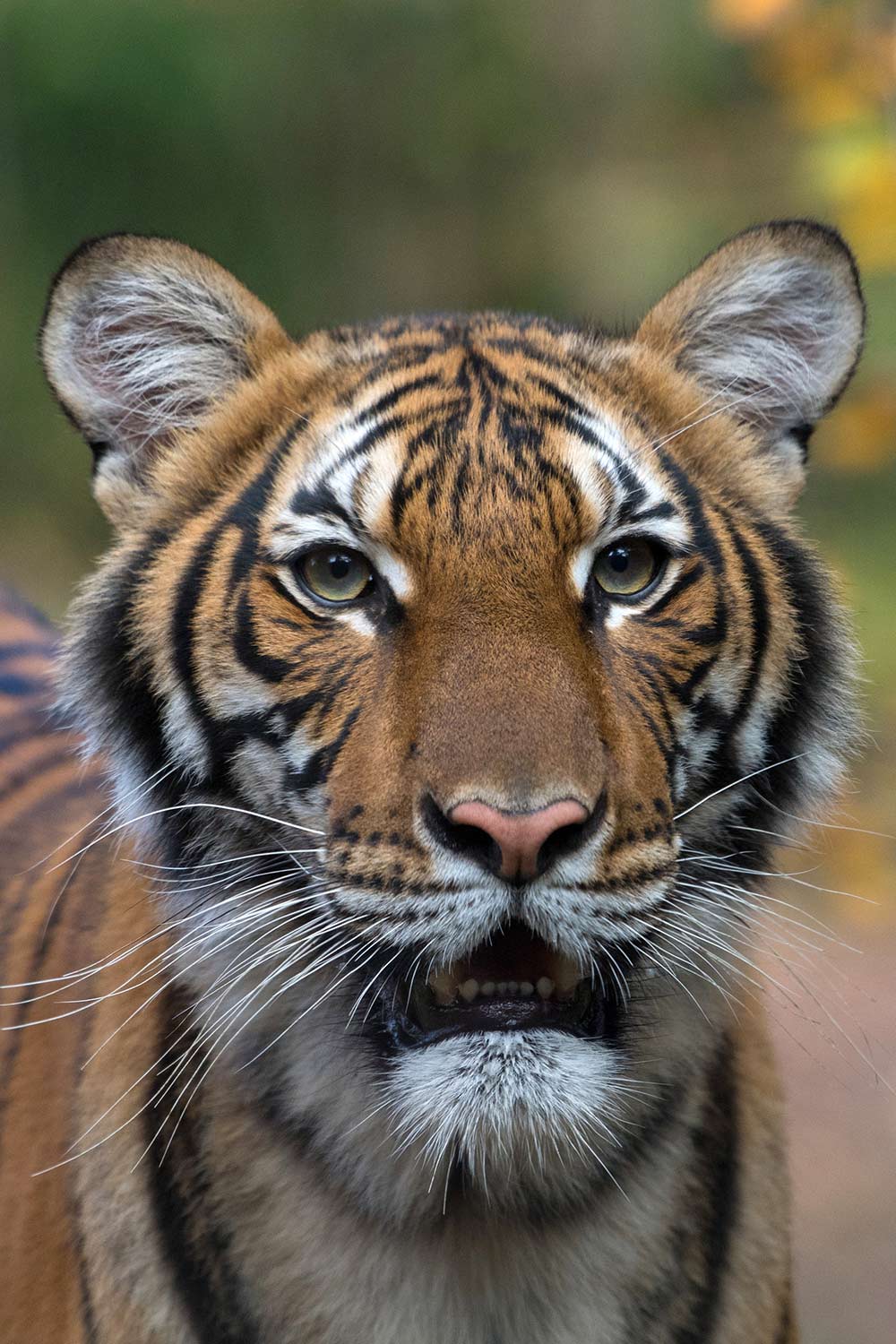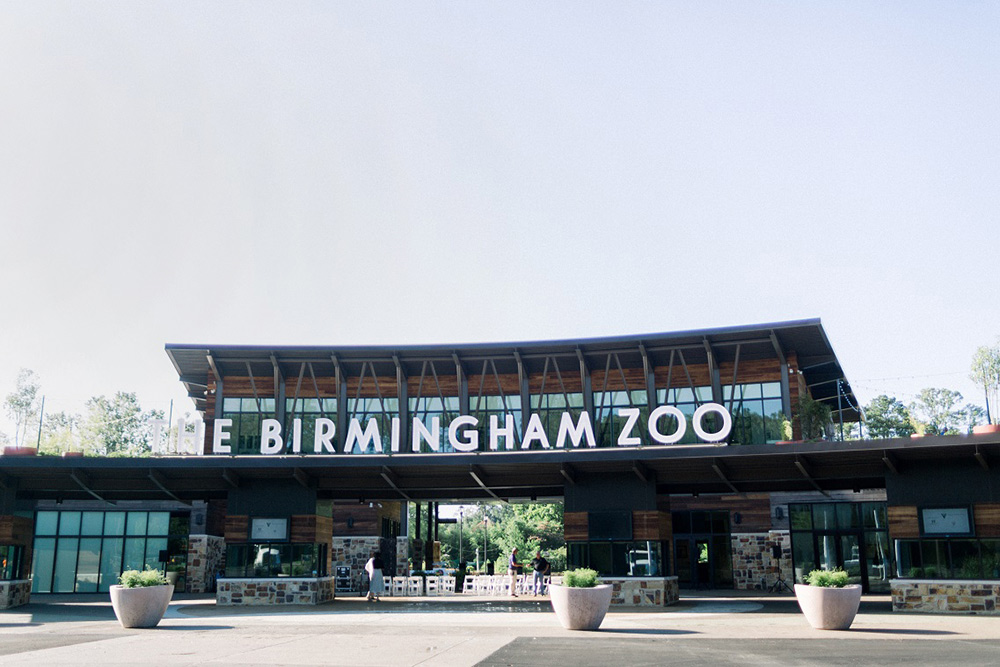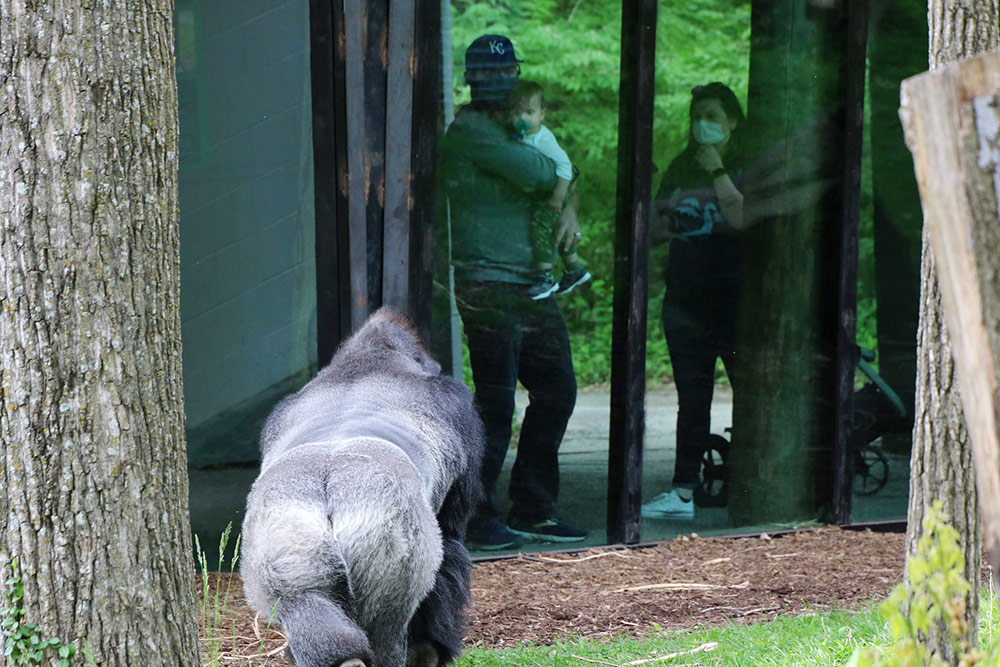生活在布朗克斯动物园(Bronx Zoo)的马来亚虎纳迪亚在4岁时,成为美国首只已知新冠检测呈阳性的动物。
自2020年4月以来,纳迪亚和其他一些老虎、狮子、美洲狮、雪豹、大猩猩和水獭等感染了新冠病毒。零星发生的野生动物感染病例在得到治疗之后病情减弱,没有出现死亡病例,但动物园管理员们很快就意识到一个可怕的事实:不仅游客和工作人员面临病毒的威胁,动物同样有被感染的风险。
说起纳迪亚新冠病毒检测呈阳性这件事情,美国动物园和水族馆协会(Association of Zoos and Aquariums)的首席执行官丹·阿什说:“这个检测结果出乎意料。”该协会是一个非营利组织,为全世界超过240家动物园和水族馆提供认证。
阿什表示,在布朗克斯动物园宣布纳迪亚检测呈阳性之后的几个小时内,各地动物园迅速采取行动,以降低动物感染病毒的风险。他们开始要求工作人员必须佩戴口罩,并在人和动物之间设置了屏障。

现在,美国超过一半人口已经接种疫苗。有关病毒的信息更容易获取,尽管可能依旧有限。美国疾病与预防控制中心(Centers for Disease Control and Prevention)取消了对接种疫苗人群的戴口罩建议,并且确诊病例大幅减少。但动物园比许多游客更关注一个重要的细节:动物依旧面临被感染的风险。
关园停业
新冠疫情爆发之后,政府执行居家隔离令,各大机构被迫停业,这对动物园行业产生了严重影响。许多动物园春季和夏季的收入大幅减少。
伯明翰动物园(Birmingham Zoo)的首席执行官克里斯·普费弗科恩说:“我们在春假一周前被迫停业,而春假是我们的主要收入来源,是我们度过阿拉巴马州炎热夏天的保证。新冠疫情确实产生了严重影响。”
普费弗科恩告诉《财富》杂志,伯明翰动物园在2020年曾经停业三个月,每天照顾动物的成本达到约30,000美元。

即使没有游客,动物们依旧需要标准护理,动物园管理员、兽医和设施维护人员都需要继续工作,打理占地数英亩的动物园。
堪萨斯城动物园(Kansas City Zoo)的首席执行官兰迪·威斯索夫称:“笼子破损,炉子关闭,管道堵塞。这些问题都需要有工作人员进行维修。”
包括堪萨斯城和伯明翰动物园在内的许多动物园都领取了两轮“薪资保护计划”(Paycheck Protection Program)贷款,用于继续发放员工工资和为动物提供高质量的护理。
阿什表示:“关键是帮助我们的会员度过2020年3月至7月这段时期。”
当地的支持对于伯明翰动物园同样至关重要。2020年,动物园的员工募款约100万美元应急资金,帮助动物园度过疫情。
普费弗科恩表示:“本地社区的慷慨解囊,帮助我们真正渡过了难关。”
动物园在重新开业之后,采取了许多创新措施,比如他们尝试了限时入园、单行道游览、无现金交易等,圣安东尼奥动物园(San Antonio Zoo)还推出了得来速式的游览服务。

接种疫苗
新冠病毒会给动物们带来多大的威胁仍不确定,还需要更多研究。
除了人工饲养的貂以外,动物感染新冠病毒的病例大部分都是孤立的,并且没有致命性。《国家地理》(National Geographic)报道称,有12,000只貂死于新冠疫情,另外,丹麦捕杀了数百万只貂,因为丹麦政府认为在貂体内形成的变异病毒可能传播给人类。
据美国农业部(U.S. Department of Agriculture)的数据显示,除了貂以外,只有215只动物新冠检测呈阳性,这个数量“较小”,这些动物感染病毒的主要原因是与阳性人类患者密切接触。截至2021年5月15日,美国农业部只收到了7,882份动物新冠检测结果。
美国疾病与预防控制中心表示,“在许多情况下”,尽管动物园工作人员配戴了个人防护装备,并遵守了防疫措施,但动物依旧在园内感染了病毒。目前没有证据证明病毒在美国的野生动物当中传播,或者野生动物是人类感染新冠病毒的主要源头。
只有少数几家动物园曾经爆发出疫情。纳迪亚所在的布朗克斯动物园有四只老虎和三头非洲狮新冠检测呈阳性。2021年1月,圣迭戈动物园(San Diego Zoo)的大猩猩也被检出阳性。在布拉格动物园(Prague Zoo),一只大猩猩和两头狮子在2月末感染了新冠病毒。
堪萨斯城动物园的威斯索夫表示,让动物园安心的是这些动物都已经康复。他说:“我们动物园并不认为新冠病毒对被感染的动物会是致命的。”
尽管如此,新冠病毒对野生动物的潜在影响依旧有许多未知数,而且相关数据有限。随着人气逐渐恢复,动物园希望谨慎应对。
堪萨斯城动物园的业务量激增。威斯索夫称,今年到目前为止其游客数量已经超过30万人,超出了动物园预测的约5万人。他表示,人们在动物园内在食物和礼品店等方面的消费增加。

为了保证动物的安全,许多动物园都设置了屏障,因为未接种疫苗的游客可能会给动物带来风险。
普费弗科恩表示,他对自己的动物园尤其担心,因为阿拉巴马州的疫苗接种率较低。《纽约时报》(New York Times)跟踪的数据显示,阿拉巴马州有约36%的人口接种了第一剂疫苗,只有29%的人口完成了接种。
普费弗科恩称:“我们强烈建议游客佩戴口罩,但这一条无法强制执行。你知道,如果动物园里有2,000人,你不可能告诉所有人戴上口罩;戴口罩不再是强制规定。”
伯明翰动物园依旧要求员工在靠近动物的时候佩戴口罩,无论员工是否接种了疫苗,并且为了鼓励员工接种疫苗,该动物园还提供了四个小时休息的机会。
虽然动物园被告知不得要求员工报告是否接种了疫苗,但普费弗科恩表示他的许多员工都主动向动物园汇报了自己的情况,并且“我们各部门大部分人”都接种了疫苗。
阿什表示,美国动物园和水族馆协会没有看到有任何会员要求人们在入园时提供接种疫苗的凭证,但他表示许多机构都提供了免费门票等激励措施,以鼓励游客接种疫苗。
另外,为了保证灵长类动物和猫科动物的安全,动物也有必要接种疫苗。2月,圣迭戈动物园为四只猩猩和五只倭黑猩猩接种了疫苗。该动物园为它们接种的是来自动物健康公司硕腾(Zoetis)的试验疫苗。
阿什认为,动物园行业对动物接种疫苗的问题“仍存在争议”,他表示许多动物园目前正在共享信息和对比不同的做法。堪萨斯城动物园和伯明翰动物园都表示,它们已经决定先耐心等待。
对于动物疫苗的进展,普费弗科恩指出:“动物疫苗目前确实还在初级阶段。我们希望为动物接种有效的疫苗,而且我们可以提供反馈和数据,用于确定对我们的动物来说最好的疫苗或者最佳接种途径。”
整个行业目前更关注的似乎是,如何围绕工作人员采取措施,以减少动物面临的风险。但野生动物爱好者希望游客能够参与进来,保证动物的安全。
普费弗科恩说:“人们来动物园参观的时候,同样有责任保证动物的健康和安全。”(财富中文网)
翻译:刘进龙
审校:汪皓
生活在布朗克斯动物园(Bronx Zoo)的马来亚虎纳迪亚在4岁时,成为美国首只已知新冠检测呈阳性的动物。
自2020年4月以来,纳迪亚和其他一些老虎、狮子、美洲狮、雪豹、大猩猩和水獭等感染了新冠病毒。零星发生的野生动物感染病例在得到治疗之后病情减弱,没有出现死亡病例,但动物园管理员们很快就意识到一个可怕的事实:不仅游客和工作人员面临病毒的威胁,动物同样有被感染的风险。
说起纳迪亚新冠病毒检测呈阳性这件事情,美国动物园和水族馆协会(Association of Zoos and Aquariums)的首席执行官丹·阿什说:“这个检测结果出乎意料。”该协会是一个非营利组织,为全世界超过240家动物园和水族馆提供认证。
阿什表示,在布朗克斯动物园宣布纳迪亚检测呈阳性之后的几个小时内,各地动物园迅速采取行动,以降低动物感染病毒的风险。他们开始要求工作人员必须佩戴口罩,并在人和动物之间设置了屏障。
现在,美国超过一半人口已经接种疫苗。有关病毒的信息更容易获取,尽管可能依旧有限。美国疾病与预防控制中心(Centers for Disease Control and Prevention)取消了对接种疫苗人群的戴口罩建议,并且确诊病例大幅减少。但动物园比许多游客更关注一个重要的细节:动物依旧面临被感染的风险。
关园停业
新冠疫情爆发之后,政府执行居家隔离令,各大机构被迫停业,这对动物园行业产生了严重影响。许多动物园春季和夏季的收入大幅减少。
伯明翰动物园(Birmingham Zoo)的首席执行官克里斯·普费弗科恩说:“我们在春假一周前被迫停业,而春假是我们的主要收入来源,是我们度过阿拉巴马州炎热夏天的保证。新冠疫情确实产生了严重影响。”
普费弗科恩告诉《财富》杂志,伯明翰动物园在2020年曾经停业三个月,每天照顾动物的成本达到约30,000美元。
即使没有游客,动物们依旧需要标准护理,动物园管理员、兽医和设施维护人员都需要继续工作,打理占地数英亩的动物园。
堪萨斯城动物园(Kansas City Zoo)的首席执行官兰迪·威斯索夫称:“笼子破损,炉子关闭,管道堵塞。这些问题都需要有工作人员进行维修。”
包括堪萨斯城和伯明翰动物园在内的许多动物园都领取了两轮“薪资保护计划”(Paycheck Protection Program)贷款,用于继续发放员工工资和为动物提供高质量的护理。
阿什表示:“关键是帮助我们的会员度过2020年3月至7月这段时期。”
当地的支持对于伯明翰动物园同样至关重要。2020年,动物园的员工募款约100万美元应急资金,帮助动物园度过疫情。
普费弗科恩表示:“本地社区的慷慨解囊,帮助我们真正渡过了难关。”
动物园在重新开业之后,采取了许多创新措施,比如他们尝试了限时入园、单行道游览、无现金交易等,圣安东尼奥动物园(San Antonio Zoo)还推出了得来速式的游览服务。
接种疫苗
新冠病毒会给动物们带来多大的威胁仍不确定,还需要更多研究。
除了人工饲养的貂以外,动物感染新冠病毒的病例大部分都是孤立的,并且没有致命性。《国家地理》(National Geographic)报道称,有12,000只貂死于新冠疫情,另外,丹麦捕杀了数百万只貂,因为丹麦政府认为在貂体内形成的变异病毒可能传播给人类。
据美国农业部(U.S. Department of Agriculture)的数据显示,除了貂以外,只有215只动物新冠检测呈阳性,这个数量“较小”,这些动物感染病毒的主要原因是与阳性人类患者密切接触。截至2021年5月15日,美国农业部只收到了7,882份动物新冠检测结果。
美国疾病与预防控制中心表示,“在许多情况下”,尽管动物园工作人员配戴了个人防护装备,并遵守了防疫措施,但动物依旧在园内感染了病毒。目前没有证据证明病毒在美国的野生动物当中传播,或者野生动物是人类感染新冠病毒的主要源头。
只有少数几家动物园曾经爆发出疫情。纳迪亚所在的布朗克斯动物园有四只老虎和三头非洲狮新冠检测呈阳性。2021年1月,圣迭戈动物园(San Diego Zoo)的大猩猩也被检出阳性。在布拉格动物园(Prague Zoo),一只大猩猩和两头狮子在2月末感染了新冠病毒。
堪萨斯城动物园的威斯索夫表示,让动物园安心的是这些动物都已经康复。他说:“我们动物园并不认为新冠病毒对被感染的动物会是致命的。”
尽管如此,新冠病毒对野生动物的潜在影响依旧有许多未知数,而且相关数据有限。随着人气逐渐恢复,动物园希望谨慎应对。
堪萨斯城动物园的业务量激增。威斯索夫称,今年到目前为止其游客数量已经超过30万人,超出了动物园预测的约5万人。他表示,人们在动物园内在食物和礼品店等方面的消费增加。
为了保证动物的安全,许多动物园都设置了屏障,因为未接种疫苗的游客可能会给动物带来风险。
普费弗科恩表示,他对自己的动物园尤其担心,因为阿拉巴马州的疫苗接种率较低。《纽约时报》(New York Times)跟踪的数据显示,阿拉巴马州有约36%的人口接种了第一剂疫苗,只有29%的人口完成了接种。
普费弗科恩称:“我们强烈建议游客佩戴口罩,但这一条无法强制执行。你知道,如果动物园里有2,000人,你不可能告诉所有人戴上口罩;戴口罩不再是强制规定。”
伯明翰动物园依旧要求员工在靠近动物的时候佩戴口罩,无论员工是否接种了疫苗,并且为了鼓励员工接种疫苗,该动物园还提供了四个小时休息的机会。
虽然动物园被告知不得要求员工报告是否接种了疫苗,但普费弗科恩表示他的许多员工都主动向动物园汇报了自己的情况,并且“我们各部门大部分人”都接种了疫苗。
阿什表示,美国动物园和水族馆协会没有看到有任何会员要求人们在入园时提供接种疫苗的凭证,但他表示许多机构都提供了免费门票等激励措施,以鼓励游客接种疫苗。
另外,为了保证灵长类动物和猫科动物的安全,动物也有必要接种疫苗。2月,圣迭戈动物园为四只猩猩和五只倭黑猩猩接种了疫苗。该动物园为它们接种的是来自动物健康公司硕腾(Zoetis)的试验疫苗。
阿什认为,动物园行业对动物接种疫苗的问题“仍存在争议”,他表示许多动物园目前正在共享信息和对比不同的做法。堪萨斯城动物园和伯明翰动物园都表示,它们已经决定先耐心等待。
对于动物疫苗的进展,普费弗科恩指出:“动物疫苗目前确实还在初级阶段。我们希望为动物接种有效的疫苗,而且我们可以提供反馈和数据,用于确定对我们的动物来说最好的疫苗或者最佳接种途径。”
整个行业目前更关注的似乎是,如何围绕工作人员采取措施,以减少动物面临的风险。但野生动物爱好者希望游客能够参与进来,保证动物的安全。
普费弗科恩说:“人们来动物园参观的时候,同样有责任保证动物的健康和安全。”(财富中文网)
翻译:刘进龙
审校:汪皓
Nadia, a Malayan tiger housed at the Bronx Zoo, was 4 years old when she became the first known animal in the U.S. to test positive for the coronavirus.
Since April 2020, Nadia and a handful of tigers, lions, cougars, snow leopards, gorillas, and otters have contracted COVID-19. The sporadic cases in wildlife have subsided with treatment, all without casualties—but not before shaking the zookeeper community with a frightening realization: Visitors and staff are at risk from the virus, but so are animals.
“It was unexpected,” Dan Ashe, CEO of the Association of Zoos and Aquariums (AZA), says of Nadia testing positive for the virus. The association is a nonprofit organization that provides accreditation status to more than 240 zoos and aquariums around the world.
Within hours of the Bronx Zoo announcing Nadia had tested positive, zoos were jumping into action to minimize coronavirus exposure among their animals, Ashe says. They began to enforce mask mandates for staff and were putting up barriers between humans and animals.
Now, more than half of the U.S. population has been vaccinated. Information on the virus is more readily available—if not still limited. The Centers for Disease Control and Prevention (CDC) has rolled back mask recommendations for vaccinated individuals, and cases have plummeted. But there’s an important detail zoos have in mind that many visitors don’t: Animals are still vulnerable.
Shutting down
The coronavirus wreaked havoc on the zookeeping industry, as stay-at-home orders forced organizations to close their doors to visitors. In many cases, spring and summer revenue fell dramatically.
“We shut down a week before spring break, which is when we make the majority of our revenue to get us through the hot Alabama summer,” says Chris Pfefferkorn, CEO of the Birmingham Zoo. “That really—that was a big impact.”
The Birmingham Zoo shut down for three months in 2020, and it was incurring about $30,000 a day in costs to care for its animals, with zero revenue coming in, Pfefferkorn tells Fortune.
Even without visitors, animals still demand their standard care—zookeepers, veterinarians, and facility workers all need to keep coming into work and taking care of the multi-acre premises.
“Cages break. Furnaces shut down. Plumbing backs up,” says Randy Wisthoff, CEO of the Kansas City Zoo. “You have to have the staff there that can fix all of that.”
Many menageries, including the Kansas City and Birmingham zoos, took out both rounds of Paycheck Protection Program loans in order to keep their staff salaried and offering quality care to the animals.
“It was critical to helping our members get through that period from March to July of 2020,” Ashe says.
Also vital in Birmingham: local support. The staff raised approximately $1 million dollars in 2020 in emergency funding to make it through the pandemic.
“The generosity of our community is really what got us through,” Pfefferkorn says.
Upon opening their doors, zoos got innovative: trying out new features like timed entry, one-way traffic, cashless transactions, or, in the case of the San Antonio Zoo, a drive-thru experience.
Vaccinations
The extent of risk the coronavirus poses to animals is still largely uncertain, and more studies are needed.
Cases of the virus in animals have largely been isolated and nonfatal—except for in farmed minks (National Geographic reported that 12,000 mink have died of COVID-19, and Denmark killed millions of mink after they were believed to have developed a mutation of the virus that could spread to humans).
Only 215 animals, excluding mink, have tested positive for the coronavirus—a “small number” that predominantly resulted from close contact with people who have tested positive—according to data from the U.S. Department of Agriculture. As of May 15, 2021, only 7,882 COVID test results for animals have been reported to the department.
Animals have, “in many situations,” developed COVID-19 in zoos despite staff wearing PPE and following coronavirus precautions, according to the CDC. There is currently no evidence that the virus is circulating among free-living wildlife in the U.S., or that wildlife could be a significant source of infection for humans.
Only a few zoos have experienced outbreaks. The Bronx Zoo, which houses Nadia, had four tigers and three African lions test positive for the virus. In January 2021, gorillas at the San Diego Zoo tested positive. At the Prague Zoo, a gorilla and two lions contracted COVID-19 in late February.
Zoos have been reassured by the recovery of these animals, according to Wisthoff at the Kansas City Zoo, who notes, “There wasn’t an overwhelming feeling at our zoo that it was going to be fatal if they did become infected.”
Even so, much is still unknown and data is limited on the virus’s potential impact on wildlife. Zoos want to err on the side of caution as their facilities begin to fill up again with visitors.
The Kansas City Zoo is experiencing an influx of business: More than 300,000 visitors have stepped through its doors so far this year, Wisthoff says, exceeding the zoo’s predictions by about 50,000. People are spending more at the zoo, between food and gift shop purchases, than ever before, he says.
Many zoos are maintaining barriers to keep the animals safe, as individuals who aren’t vaccinated can pose a risk.
Pfefferkorn says he is particularly concerned about his zoo given the low vaccination rates in Alabama. About 36% of Alabamians have received one coronavirus shot, and only 29% are fully vaccinated, according to data tracked by the New York Times.
“We’re highly recommending our visitors wear masks, but you can’t enforce it,” Pfefferkorn says. “You know, if we had 2,000 people out there, there’s no way we can tell everybody to keep their mask on; there is no more mandate.”
The Birmingham Zoo is still telling its staff members to wear masks around the animals, with or without the vaccine, and it offered a four-hour time-off incentive to encourage its employees to get a vaccine.
While the zoo was advised that it could not require its employees to report whether or not they had been vaccinated, Pfefferkorn says many of his staff are self-reporting and that “most of our departments” have been vaccinated.
Ashe of the AZA says he hasn’t seen any of its members require people to present proof of vaccination for entry, but he said that many institutions are offering incentives such as free admission to encourage visitors to do so.
There is also a case to be made for animal vaccinations, in order to keep primates and felines safe. In February, the San Diego Zoo vaccinated four of its orangutans and five bonobos. The zoo used an experimental vaccine from animal health company Zoetis.
The vaccination of animals is an “ongoing debate” within the menagerie community, according to Ashe, who says many zoos are sharing information right now and comparing practices. Both the Kansas City and Birmingham zoos say they have decided to wait it out for now.
“It’s still in a real early stage,” Pfefferkorn says of animal vaccine development. “We want to make sure that when we vaccinate our animals it’s effective and we can provide feedback and data to try to determine what the best vaccine or route of administration would be for our animals.”
The industrywide focus currently appears to be centered more on the measures zoos can take among their staff to lessen the risk for animals. But wildlife lovers are hoping that visitors will partake in some of the burden to keep animals safe.
“When people visit the zoo, they have some responsibility for animal health and safety as well,” Pfefferkorn says.






